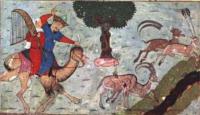You are here
From Alexander to Kushans.

Tours on famous sights of Samarkand.
“He who conquers himself is the mightiest warrior”
Confucius.
Destinations and tours Samarkand.
In the 340s -330s B.C., Western Asia was stirred by Greco-Macedonian conquest. The Persian empire of the Achaemenids was smashed. After defeat of Bess, the last Achaemenid commander and Bactrian satrap, Alexander the Great suddenly faced stout resistance of the Sogdians, headed by Spitamenes and allied with the Sakaes and Massagetaes. For several years, Spitamenes had checked the advance of Greco-Macedonian reserves in Sogdiana and Bactria.
Alexander personally commanded a punitive expedition against Spitamenes and had to fix his camp in the capital of Sogdiana, Marakanda (Samarkand). Near the city, the Macedonian king hunted lions in the royal natural reserve of Basista.
When Alexander appointed his fellow in arms and foster-brother Cletus to a post of Sogdiana governor, the latter said, You appoint me to Sogdiana, which was rebellious so many times and has not been conquered yet, and moreover, can not be ever conquered.
Later, at the feast in Marakanda, awful tragedy happened - flying into rage, Alexander killed Cletus. After suppression of Spitamenes, Alexander destroyed Marakanda. As Diodorus informed, one hundred twenty thousand people were killed in the valley of Zerafshan.
Blossoming Sogdiana had been ruined. However, at the time of the Seleucids, it revived and became again one of the utmost lands of the Hellenic culture. In the 3rd century - first half of the IInd B.C., Sogdiana was a part of the Greco-Bactrian realm.
In the middle of the IInd century B.C., the tribes of Yuech-chi (Yuezhis in Chinese sources), pressed by the Huns from the east, invaded Central Asia and smashed Greco-Bactrian kingdom, forcing Sakae tribes to the south.
Chinese pilgrim Chang Тien informed that at the second half of the IInd century B.C., at the middle Syr-Darya (the valleys of Zerafshan and Kashka Darya) was formed a strong confederation of principalities Qangui, which population reached 600 thousand people.
By the beginning of Christian era, the Yuech-chi formed the powerful Kushan realm on Bactrian lands and southward from them. The Kushans set strong fortification line along the border of Qangui in the canyon of the south-western Guissar.
It gives the clear evidence for a strain character of their neighborhood relations. In the 1st- 2nd centuries, Qangui expanded to the west, down to Khorezm, and the Kushan kings conquered the lands in Northern India.
Sogdiana, as a part of Qangui confederation, was formed by a number of independent Sakae and Yuech-chiТs domains. The strategic position on the crossroads of trading routes from China, India, Parthia and Great Steppe predetermined generation and blossoming of unique Sogdian culture, synthesizing the best achievements of the West and East, local cults and Zoroastrianism.
The Sogdian script became wide spread. Like the Phoenicians at the Mediterranean, the Sogdians energetically colonized eastern routes of the Great Silk Road. Besides silk, fabrics from cotton and hemp, gold, silver, copper, weapon and armour, odorous gums, furs, carpets and clothes, ceramics, glass and porcelain, jewelry, semi-precious stones and mirrors were articles of international trade.
Authority:
Alexey Arapov. Samarkand. Masterpieces of Central Asia. Tashkent, Sanat. 2004.







